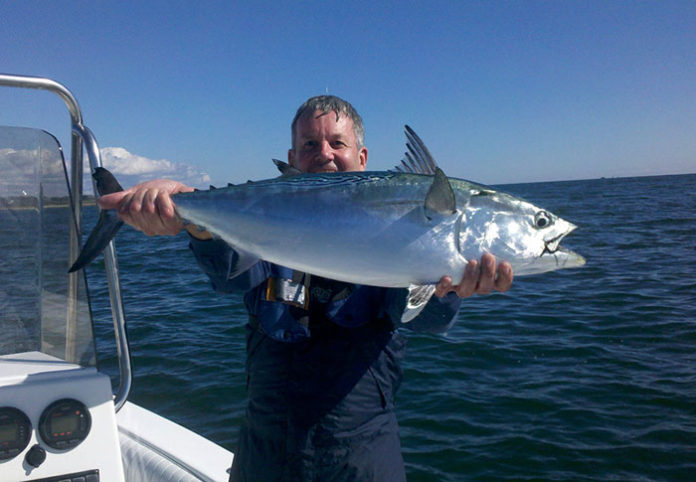The false albacore (Euthynnus alletteratus) goes by many names—little tunny, fat albert, bonito, spotted bonito—but whatever anglers call it, the species is prized for its blistering runs and sheer power. One of the smaller members of the Scombridae family, the false albacore is not a “true” tuna, of the genus Thunnus, and is, in fact, more closely related to the mackerels. The species’ streamlined body, powerful tail, and pelagic lifestyle make it pound-for-pound one of the most powerful game fish a fly fisher can hook into.
Range and Life History
False albacore are the most common tunas in the Atlantic Ocean, and their range extends from New England to Brazil and from Great Britain to South Africa. They are also found in the Mediterranean and Black Seas, where the average fish is much larger. In their northern range, they average 10 to 12 pounds, whereas fish caught off North Carolina often approach the 20-pound mark. The world-record fish, caught in the deep water of the Washington Canyon off the coast of New Jersey in 2006, weighed an astonishing 36 pounds and was 48 inches long.
Dave Woolley with a false albacore that most likely would have broken the Connecticut state record.
Photo by Chick Corrado
Although they are classified as a pelagic, or open-water, fish and travel in very large schools, false albacore prefer relatively warm water and spend much of their lives in near-shore and inshore waters, making them more available to anglers, especially in autumn. They can often be found wherever baitfish congregate—in inlets, around jetties, and sandbars. Baitfish make up the majority of the albies’ diet, although they will also feed on crustaceans and squids. Like other fish that feed in schools, false albacore will drive bait to the surface or into shore in order to concentrate the food.
Like most tunas, albies lack a swim bladder, which means they must be in constant motion, which explains their phenomenal swimming power. They are fast-growing, but short lived, reaching sexual maturity at one year of age and 15 inches but rarely living more than five years. Spawning occurs in deep, offshore waters from April through November. The flesh of the false albacore is dark and coarse in texture, so few people in the U.S. eat it, although it is consumed in other parts of its range.
Chasing the Blitz
The first big cold front of autumn usually kicks off the annual blitz of false albacore, which then travels southward along the Atlantic Coast. Big schools move into Vineyard Sound, off the southern shore of Cape Cod, in September. By mid-October, the waters off North Carolina are swarming with bait coming out of the large sounds, offering some of the best fishing for larger albies, in places such as Harker’s Island and Beaufort. Whereas the species was once considered a “trash fish” by Florida anglers because of its poor table quality, more and more Sunshine State anglers are recognize its value as a game fish when other, more glamorous species aren’t available.
Flies
The best fishing for false albacore occurs when the water temperature is in the 60s, there’s plenty of bait, and the water is moving. As is often the case in salt water, diving birds are often the surest sign that the false albacore are herding bait to the surface. Some hardcore albie anglers believe that matching the baitfish is the key to success, and they often use smaller flies—from size 2 to size 8—than they would for striped bass or similar species. Others believe that a fly that contrasts with the predominate bait will get noticed. Patterns such as the Surf Candy, Clouser Minnow, and bunny flies are popular choices, and most saltwater gurus suggest an intermediate line.
Click here to hear a classic Orvis Fly Fishing Guide Podcast on false albacore.

Matt Canter with a false albacore taken off the coast of North Carolina.
Photo courtesy Matt Canter
Credit: Source link































